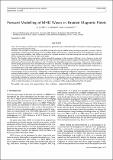Files in this item
Forward modelling of MHD Waves in braided magnetic fields
Item metadata
| dc.contributor.author | Fyfe, Lianne | |
| dc.contributor.author | Howson, Thomas Alexander | |
| dc.contributor.author | De Moortel, Ineke | |
| dc.date.accessioned | 2020-09-18T14:30:09Z | |
| dc.date.available | 2020-09-18T14:30:09Z | |
| dc.date.issued | 2020-11 | |
| dc.identifier | 270210419 | |
| dc.identifier | e866e308-c6c8-495b-93db-390d67a9fdff | |
| dc.identifier | 85095969020 | |
| dc.identifier | 000591273300005 | |
| dc.identifier.citation | Fyfe , L , Howson , T A & De Moortel , I 2020 , ' Forward modelling of MHD Waves in braided magnetic fields ' , Astronomy & Astrophysics , vol. 643 , A86 . https://doi.org/10.1051/0004-6361/202038945 | en |
| dc.identifier.issn | 0004-6361 | |
| dc.identifier.other | ORCID: /0000-0002-1452-9330/work/98487482 | |
| dc.identifier.other | ORCID: /0000-0002-4895-6277/work/98488073 | |
| dc.identifier.uri | https://hdl.handle.net/10023/20646 | |
| dc.description | Funding: UK Science and Technology Facilities Council (consolidated grants ST/N000609/1 and ST/S000402/1) and the European Union Horizon 2020 research and innovation programme (grant agreement No.647214). IDM acknowledges support from the Research Council of Norway through its Centres of Excellence scheme, project number 262622. | en |
| dc.description.abstract | Aims. We investigate synthetic observational signatures generated from numerical models of transverse waves propagating in complex (braided) magnetic fields. Methods. We consider two simulations with different levels of magnetic field braiding and impose periodic, transverse velocity perturbations at the lower boundary. As the waves reflect off the top boundary, a complex pattern of wave interference occurs.Weapply the forward modelling code FoMo and analyse the synthetic emission data. We examine line intensity, Doppler shifts and kinetic energy along several line-of-sight (LOS) angles. Results. The Doppler shift perturbations clearly showed the presence of the transverse (Alfvénic) waves. However, in the total intensity (and running difference), the waves are less easily observed for more complex magnetic fields andmay be indistinguishablefrom background noise. Depending on the LOS angle, the observable signatures of the waves reflect some of the magnetic field braiding, particularly when multiple emission lines are available, although it is not possible to deduce the actual level ofcomplexity. In the more braided simulation, signatures of phase mixing can be identified. We highlight possible ambiguities in the interpretation of the wave modes based on the synthetic emission signatures. Conclusions. Most of the observables discussed in this article behave in the manner expected, given knowledge of the evolution of the parameters in the 3D simulations. Nevertheless, some intriguing observational signatures are present. Identifying regions of magnetic field complexity is somewhat possiblewhen waves are present although even then, simultaneous spectroscopic imaging from different lines is important to identify these locations. Care needs to be taken when interpreting signatures in the intensity and Doppler velocities as torsional motions as in our setup, such signatures were a consequence of the complex nature of the magnetic field rather than real torsional waves. Finally, we investigated the kinetic energy, estimated from the Doppler velocities, which is highly dependent on the polarisation of the wave, complexity of the background field and the LOS angles. | |
| dc.format.extent | 15 | |
| dc.format.extent | 9998636 | |
| dc.language.iso | eng | |
| dc.relation.ispartof | Astronomy & Astrophysics | en |
| dc.subject | Sun: corona | en |
| dc.subject | Sun: magnetic fields | en |
| dc.subject | Sun: oscillations | en |
| dc.subject | Magnetohydrodyanmics (MHD) | en |
| dc.subject | QB Astronomy | en |
| dc.subject | QC Physics | en |
| dc.subject | NDAS | en |
| dc.subject.lcc | QB | en |
| dc.subject.lcc | QC | en |
| dc.title | Forward modelling of MHD Waves in braided magnetic fields | en |
| dc.type | Journal article | en |
| dc.contributor.sponsor | Science & Technology Facilities Council | en |
| dc.contributor.sponsor | European Research Council | en |
| dc.contributor.sponsor | Science & Technology Facilities Council | en |
| dc.contributor.institution | University of St Andrews. Applied Mathematics | en |
| dc.identifier.doi | https://doi.org/10.1051/0004-6361/202038945 | |
| dc.description.status | Peer reviewed | en |
| dc.identifier.grantnumber | ST/N000609/1 | en |
| dc.identifier.grantnumber | 647214 | en |
| dc.identifier.grantnumber | ST/S000402/1 | en |
This item appears in the following Collection(s)
Items in the St Andrews Research Repository are protected by copyright, with all rights reserved, unless otherwise indicated.

